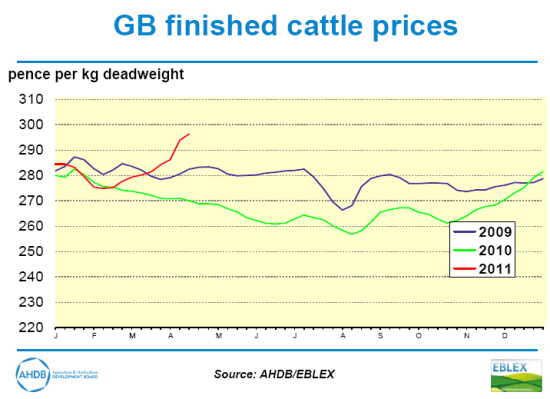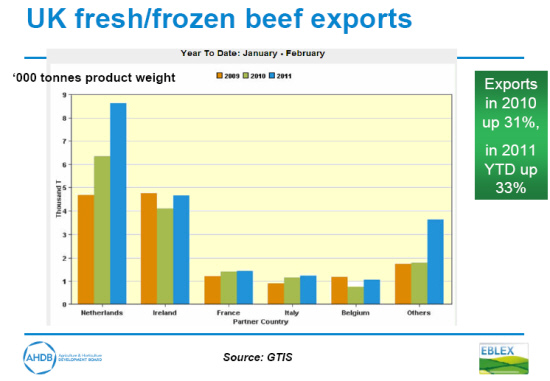



UK Beef Production Forecast To Fall
More male dairy calves are being reared to be finished as young bulls for slaughter, writes TheCattleSite editor-in-chief, Chris Harris.The increase in the number of young bulls being sent for slaughter was seen last year and has continued in the first quarter of this year, ADHB market analyst for meat Mark Topliff told the recent Outlook 2011 conference in London.
He said that from a relatively stable position in 2009, cattle prices dipped in 2010 and have reached nearly 300p per kg in the first quarter of the year - a high for Great Britain.
In the first quarter of this year the cattle slaughter numbers had risen by 8.5 per cent.
In the 2009/10 year the number of dairy males going to slaughter rose by 46 per cent while the number of beef males going for slaughter went up by just one per cent. This year - 2010/11 - the number of dairy males has risen by another 41 per cent and the number of beef male cattle at slaughter was up by 1.6 per cent.

Mr Topliff said that last year also saw a rise in carcase weights as the farmers had started to feed cattle grain to build up weight.
However, he said that this year with the high grain prices carcase weights could fall.
He said that while steer prices are below those of the last two years they are starting to close up.
The market has also seen a rise in the numbers of cows slaughtered, but this has had no real effect on prices. Both dairy and beef cow slaughter numbers have rise with dairy cow slaughter numbers up nine per cent last year and 16 per cent this year and beef cow numbers up by 21 per cent last year and 34 per cent this year - 2010/11.
The strength of sterling against the Euro has helped with exports, with trade to EU countries rising.
Imports in the 2009/10 year were up by three per cent but have fallen this year, with most of the imports coming from Ireland.
Mr Topliff said that the UK has also seen less beef coming in from Brazil than in previous years as Brazil is starting to focus on other more lucrative markets.

On the retail market, beef sales are down by five per cent this year compared to a three per cent rise in the previous year, although sales of minced beef that account for 50 per cent of sales are up by 2.8 per cent.
Mr Topliff said the forecast is for a slight drop in the beef herd this year and level numbers in the dairy herd with cow and heifer slaughter figures rising.
Prime cattle slaughterings are expected to fall from 2.098 million head in 2010 to 2.057 million this year and 2.055 next year, with production falling from 909,000 tonnes in 2010 to 884,000 tonnes this year and 875,000 tonnes next year.

Imports are also expected to drop as cattle numbers in Ireland fall.
"We are looking at supplies available for consumption to be lower both this year and next compared to 2010," he told the conference.
"Exports will be higher as production falls across the EU."
He added that the dairy breeding herd will stabilise and the beef breeding herd will return to the 2009 level.
Fewer male dairy calves will be available for slaughter from the second half of 2011 and there will be fewer slaughterings and carcase weights will be lower, so there will be a fall in production.
Mr Topliff added that the uncertain UK economic situation over next 18 months together with fall in production will impact on consumption.


